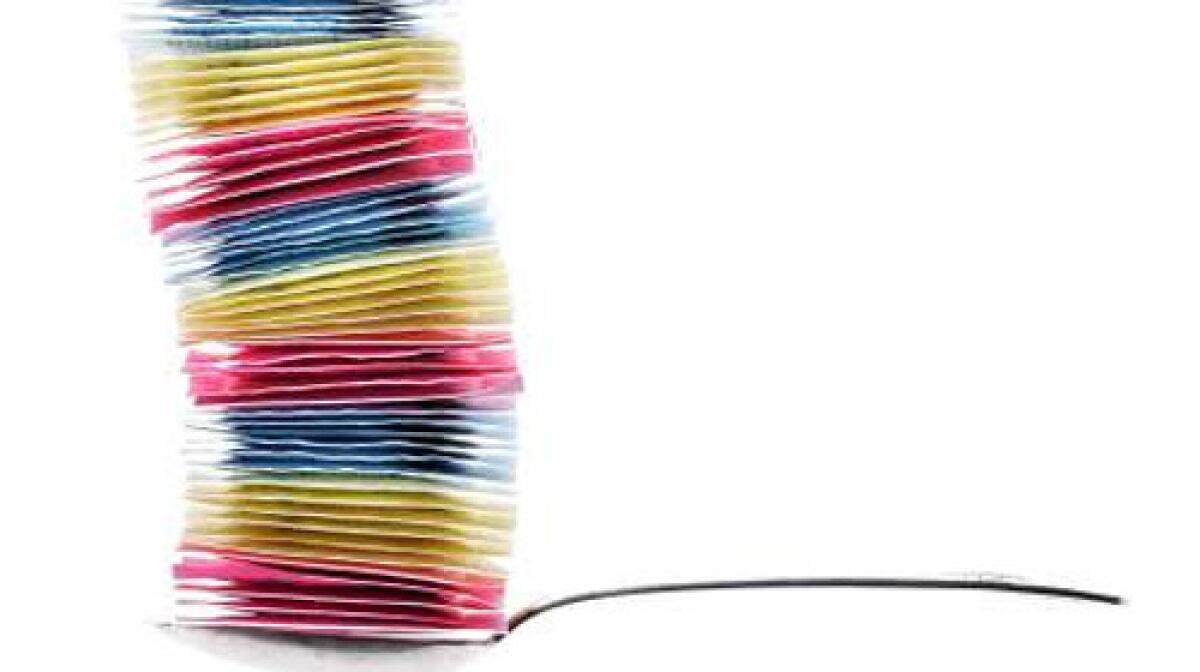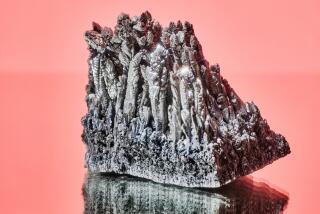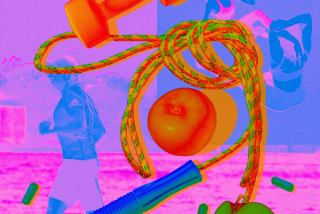With faux sugars, real suspicion

What is it about artificial sweeteners?
As never before, they pervade the American diet -- in pink, yellow and blue packets on diner counters, in sugar-free cookies and diet juices, in sodas and smoothies and low-calorie yogurt and boxes of powder for baking.
And, as ever, many Americans view them with suspicion.
Every few years, a study links one to cancer. People get scared. Follow-up research finds nothing to worry about. Decades may pass, but sooner or later another scary study comes along. And still, we keep eating these faux sugars.
Today, nearly 200 million Americans consume sugar-free or low-calorie products, according to the Calorie Control Council, a group that represents the diet food industry. About half of those people consume an average of four of these products every day.
FOR THE RECORD:
Artificial sweeteners: A Nov. 19 story on artificialsweeteners said that the nation’s annual soft drink sales were $200million and attributed the figure to John Sicher, editor andpublisher of the trade journal Beverage Digest. Sicher provided thecorrect figure of $70 billion.
Diet sodas make up 29% of the nation’s $200-million annual soft drink sales, and the percentage is rising, says John Sicher, editor and publisher of the trade journal Beverage Digest.
That we’re consuming artificial sweeteners is clear. Whether we’ll ever do so with total ease is not. Suspicions about the safety of man-made sweeteners started soon after saccharin was invented more than a century ago. Studies, later disputed, led to warning labels on one sweetening product, the banning of another, intermittent mistrust of others.
The most recent volley in the sweetener wars came from researchers in Italy who say aspartame causes cancer in rats. Similar fears have been levied about newer sweeteners, including sucralose, commonly known as Splenda.
Supporters and critics of the substances each criticize the methods and motives of the other side. Many food chemists say it is impossible for people to eat or drink enough of any man-made sweetener to cause health problems.
Sweetener skeptics, on the other hand, say that safety studies are often funded with industry dollars and there aren’t enough data to be sure about the safety of most artificial sweeteners.
Behind the seemingly endless cycles of debate, there may be something cultural at work in the way we think about what we eat, says USC sociologist Barry Glassner, author of “The Gospel of Food,” which urges people to abandon food fads in favor of calmer attitudes toward eating.
A few generations ago, Glassner says, people looked to science and technology as salvation -- it was the time of Kool-Aid, Tupperware and pasteurized processed cheese.
Today, he says, there’s an increasing emphasis on “natural,” a view that demonizes anything in our food that comes out of labs. Instead of electric colors and chemical flavors, increasingly our culture worships whole grains, organic greens and local produce.
“There is tremendous nostalgia, right now, for an imagined past in which everything we ate was pure and came straight out of some magically clean Earth,” Glassner says. “That never existed -- except in our imagination.”
In line with this cultural shift, some people are turning to a new crop of sweeteners based on “natural” ingredients, such as stevia, a calorie-free herb from South and Central America. Already popular in Asia, stevia is now available in the U.S. in natural food stores (U.S. food companies can’t yet include it in their products), and sales of it rose 19% in the last year, according to SPINS, a natural-products market research firm.
Cargill Inc. is working with Coca-Cola Co. to test the safety of what they say is an aftertaste-free stevia-derived sweetener, rebiana, which they hope to introduce to American taste buds.
The Food and Drug Administration has approved five artificial sweeteners for use in the United States: saccharin (found in Sweet’N Low and Tab), aspartame (in NutraSweet, Equal, Diet Coke and Diet Pepsi), sucralose (Splenda, and in Diet Hanson’s sodas), neotame (in newer formulations of Tang and some sparkling waters) and acesulfame potassium (Sweet One, Sunnett and, with Splenda, in Diet Snapple and Diet Rite). Others are under review.
Another sweetener, cyclamate, which used to be in the U.S. versions of Tab and Fresca, has been banned in the United States for decades, after studies -- later disputed -- conducted in the 1960s and 1970s showed a cancer link in rodents.(Cyclamate is legal in Canada and in dozens of other countries and is found in Canadian Sweet’N Low instead of saccharin. That’s because saccharin -- legal in the U.S. -- is banned in Canada.)
Each sweetening product uses a different type of molecule (or blend of them) to trick the tongue into thinking it’s tasting something sweet. Thanks to the substances’ chemistry, it takes only a tiny amount of each to trigger the same taste receptors that recognize sugar molecules. That makes them hundreds and in some cases tens of thousands of times sweeter than the real stuff. (A can of Coke, for example, contains about 10 teaspoons of sugar, while a can of diet Coke contains less than a tenth of a teaspoon of aspartame.)
Because artificial sweeteners work in such small quantities, they add virtually no calories to a drink or food. Some, in fact, aren’t even digested by the body. And, unlike sugar, none raise insulin or glucose levels, making them popular with diabetics.
Saccharin and aspartame, which have been around the longest, have received the most heat from studies investigating their safety.
--
Saccharin
Saccharin first hit human taste buds in 1879, when a Johns Hopkins University chemist accidentally spilled a substance he was working with on his hand and later noticed a sweet taste while eating dinner. Its popularity grew during the sugar shortages of World War I; Sweet’N Low hit the U.S. market in 1957.
In 1975, a Canadian study found that male rats experienced increased rates of bladder cancer after consuming high doses of saccharin. Media reports at the time stated that the amount rats were eating was the equivalent of a person drinking 800 diet sodas a day. Other studies had similiar findings, and as a result, from 1981 until 2000, products containing saccharin required warning labels in the U.S.
The requirement was reversed after the U.S. National Toxicology Program at the National Institute of Environmental Health Sciences found fault with the data and removed saccharin from the list of suspected human carcinogens. (The FDA banned cyclamate in 1970 based on similar evidence of bladder cancer in rats. But later studies failed to verify the link, and the FDA is reconsidering.)
Some scientists disagree with the decision to de-list saccharin in the U.S. and wish that more studies were being done. Toxicologist James Huff, associate director for chemical carcinogenesis at the National Institute of Environmental Health Sciences, says the decision was more political than scientific.
“In my experience . . . when you find something that is carcinogenic in animals, we have to believe that it will cause cancer in humans under certain exposure circumstances, “ Huff says.
--
Aspartame
Aspartame was first linked to cancer in the 1970s, when hundreds of rats exposed to the chemical developed higher rates of brain tumors. Then, in 1996, scientists attempted to link an observed four- to fivefold rise in human brain cancer between the late 1970s and mid-1980s to increased use of aspartame.
But further analysis found inconsistencies in both sets of data. Long-term rodent studies over the decades have found no signs of harm. And a 2006 analysis of 10 years’ worth of data from more than 450,000 adults collected by the National Cancer Institute showed no link between aspartame use and cancer rates.
But the aspartame discussion isn’t over. In two studies published in the journal Environmental Health Perspectives in 2006 and 2007, a group at the European Ramazzini Foundation of Oncology and Environmental Sciences in Bologna, Italy, presented what they say is the first real evidence that aspartame causes multiple types of cancer in animals.
In their first study, the Ramazzini group exposed hundreds of 8-week-old rats to varying doses of aspartame. In the second, they began exposing rats to aspartame as fetuses.
The Italian researchers reported that their rats started to develop nearly twice as many cases of lymphoma, leukemia and other cancers when consuming the equivalent of 20 milligrams of aspartame per kilogram of body weight.
By comparison, the average American consumes about 5 milligrams per kilogram of body weight daily. And the FDA recommends people eat no more than 50 milligrams/kilogram of body weight each day -- the equivalent of 97 packets of Equal, or 20 cans of diet soda, for a 150-pound person.
Based on its findings, the Italian group has urged governments to review regulations about aspartame in foods and beverages, especially ones consumed by children.
The researchers can’t yet explain how aspartame might cause cancer, but one theory involves the sweetener’s chemical structure. Aspartame contains two harmless amino acids found in proteins but also a compound called methanol, which is broken down by the body into formaldehyde and other byproducts. In large doses, methanol can cause blindness; formaldehyde can cause cancers such as leukemia.
In response to the Italian research, the European Food Safety Authority, Europe’s FDA equivalent, reviewed the evidence on aspartame and issued a 40-page report reaffirming the sweetener’s safety. Other regulatory agencies followed suit.
And in September, a panel of 10 American researchers conducted a review of more than 500 aspartame studies and concluded that the chemical is safe. Its report, published in Critical Reviews in Toxicology, expressed a long list of concerns about the Ramazzini studies.
For example, the rats used by the Italian group had long had major problems with chronic respiratory disease, which often leads to lymphomas and leukemia. “These are really sick animals,” says University of Maryland toxicologist Bernadene Magnuson, a panel member.
In addition, Magnuson says, the animals were caged in groups and “we have no way of knowing how much each rat was eating.” Small rats could eat as much aspartame as large ones, even though the same amount of the chemical has a bigger effect on smaller creatures.
The Italian studies’ findings also contrast starkly with others conducted on aspartame, Magnuson adds. The panel analyzed a dozen, more carefully regulated studies and found that rodents in those had tolerated daily exposures of up to 10,000 milligrams/kilogram of aspartame -- the equivalent of 19,400 daily packets of Equal for an average adult human -- with no ill effects.
“I have no question in my mind that it is safe to consume aspartame, and I’d rather consume that than empty calories with a full-sugar soda,” Magnuson says. “My kids too.”
Eric Walters, a biochemist at Rosalind Franklin University of Medicine and Science in North Chicago, Ill., says he finds the toxic-methanol argument hard to stomach.
“You couldn’t possibly consume enough diet soft drink to get a toxic dose of methanol,” says Walters, who worked for the NutraSweet Co. from 1982 to 1991. “You would need 100 cans at a sitting.” A cup of fruit juice, he adds, contains as much methanol as a cup of diet soft drink.
But the Italian group is sticking to its guns, as are some scientists in the U.S. Some claim that industry affiliations among panel members make it hard to trust the U.S. report’s conclusions and note that the review was funded by Ajinomoto Food Ingredients, a major producer of aspartame. (The panel was not told who had commissioned the report until it was completed, Magnuson says.)
In an open letter in June to the FDA, 11 doctors and PhDs argued that letting the animals live into old age, one of the most controversial aspects of the Italian studies, more accurately mimics how aspartame might affect people throughout their lifetimes. More studies, they say, should be done the same way.
“To me, the Ramazzini studies are the future,” says Huff, one of the signatories.
--
Sucralose
Sucralose, one of the newer sweeteners, has also gotten its share of attention -- positive and negative. Commonly known as Splenda, sucralose was approved for U.S. use in 1998. Since then, it has become popular as a sugar substitute in baked goods because, unlike aspartame and other alternatives, it keeps its chemical structure when heated, and its shelf life is relatively long.
Splenda riled the Sugar Assn. and inspired a flurry of lawsuits -- finally settled this spring -- with its marketing slogan, “Made from sugar, so it tastes like sugar.” The makers of Equal sued Splenda’s marketers on the grounds that the ad campaign was false and misleading.
A Sugar Assn.-funded website, www.truthaboutsplenda .com, also criticizes Splenda’s attempts to seem as natural as sugar and says that a lack of long-term studies makes Splenda’s safety uncertain.
Sucralose does begin life as the sugar molecule sucrose, but a number of chemical alterations follow, including the addition of a chlorine atom. Studies so far have failed to show that Splenda is unsafe, however, and most scientists dismiss the idea.
“There is no direct evidence” that Splenda causes cancer, says Dr. David L. Katz, director of the Yale Griffin Prevention Research Center in New Haven, Conn. “It’s just a theoretical concern.”
--
Acesulfame potassium
A less-known target of anxiety is a sweetener called acesulfame potassium, also known as acesulfame K or Ace K, and marketed as Sweet One or Sunnett.
The FDA approved the chemical for use in soft drinks in 1998, but Myra Karstadt, a consulting toxicologist and adjunct faculty of the department of environmental and occupational health at the Drexel University School of Public Health in Philadelphia, says the approval was based on poorly designed studies, flawed data and doubtful interpretation of statistics.
In 1996, Karstadt and Michael Jacobson, executive director of the Washington-based consumer group Center for Science in the Public Interest, began urging the FDA and the National Toxicology Program to conduct long-term studies on the chemical. What data there are, Karstadt and Jacobson say, suggest that Ace K causes cancer in rodents.
In the last few years, Ace K has steadily gained shelf space as an add-on to products containing sucralose. The Splenda-Ace K blend has become a popular ingredient in baked goods because of the combination’s taste and because it retains its sweetness when heated to high temperatures. Ace K also appears in products such as puddings, frozen meals and fruity drinks. But most consumers don’t know it’s there because, unlike other sweeteners, Ace K is never advertised on the fronts of food packaging.
Repeatedly, Huff adds, the FDA has turned down proposals to further test aspartame, Ace K and other sweeteners.
“There should be more studies,” Jacobson says, but he’s not holding his breath. “The only ones with the incentive to study them are the companies marketing them. If they say it causes cancer, they’re out of business.”
No matter which type of cookies and soda people choose, one thing is clear: We are a nation pulled in opposite directions by two conflicting desires. We crave sweets, yet we are obsessed with our weight and anything that claims to be a magic elixir for weight loss.
Artificial sweeteners, Katz says, have been around for a long time. If we were going to see an epidemic of cancer, he says, we would already have done so.
He opposes artificial sweeteners for a different reason -- there is no convincing evidence, he says, that products containing them help people lose weight.
They may do the opposite. For every study that suggests eating low-calorie foods leads to a short-term reduction in calorie consumption, another finds that people who consume diet foods and beverages add just as many calories -- if not more -- to other parts of their diet, he says.
Katz adds that eating large amounts of sweets -- regular or diet -- increases our tolerance for, and addiction to, sweetness. Bathe your taste buds in Diet Coke all day long and you may be more likely than someone consuming fewer sweets to need a sickeningly sweet dessert or sugar-enhanced pasta sauce or salad dressing to feel satisfied.
“The word ‘diet’ [in diet food products] is a misnomer,” Katz says. “At this point, I am thoroughly convinced that they undermine that goal.”






